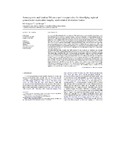| dc.description.abstract | Aeromagnetic (AM) and Landsat Thematic Mapper (TM) data from the south-central Zimbabwe Craton have
been processed for the purpose of regional structural mapping and thereby to develop strategic models for
groundwater exploration in hard-rock areas. The lineament density is greater on TM than on AM images,
partly due to the resolution of the different datasets, and also because not all TM lineaments have a magnetic
signature. The derived maps reveal several previously undetected lineaments corresponding to dykes, faults,
shear zones and/or tectonically-related joints, striking predominantly NNE, NNW and WNW. We suggest the
possible hydrogeological significance of some of these patterns as follows: the aeromagnetic data can be used
to map faults and fractures of considerable depth which are likely to be open groundwater conduits at depth
(typically under tension), while TM lineaments, although not necessarily open (mostly under compression),
represent recharge areas.
The interpreted persistent lineation and well developed fracture patterns are correlated with existing
boreholes and indicate a spatial relationship between regional structures and high borehole yields (N3 m3/h).
This relationship is combined with other lithological and hydrogeological information to identify potential
regional groundwater sites for detailed ground investigations. These are defined as dyke margins, faults,
fractures/joints or intersections of any combination of these structures. Priority should be given to coincident
AM/TM lineaments (e.g., NNW and NNE fractures) and continuous structures with large catchment areas
(e.g., NNE and WNW faults). The late Archaean (2.6 Ga) granites are considered the most favourable unit
because of their associated long and deep brittle fractures between numerous bornhardts (inselbergs) and
kopjes. Several small-scale TM lineaments also form important local sources of groundwater for hand-dug
wells. Based on measured rock susceptibilities from the area, we present a model of the typical magnetic
responses from the possible groundwater exploration targets. The developed magnetic model could be
applicable to similar terrains in other Archaean Cratons. | en_US |

